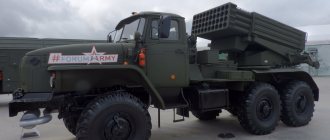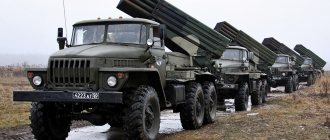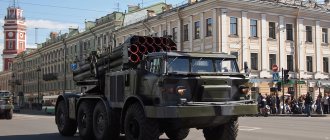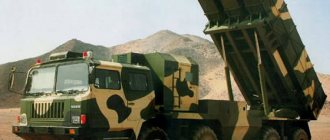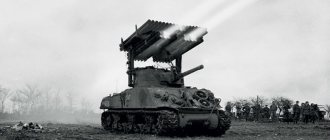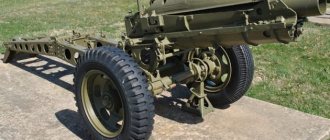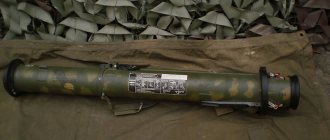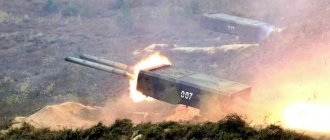Type of multiple launch rocket system
| BM-14 | |
| Launcher (BM-14) 140 mm caliber, 16 rounds, mounted on a GAZ-63 truck. | |
| Type | Multiple rocket launcher |
| Place of origin | Soviet Union |
| Service history | |
| In service | 1952 - c.1990 (USSR) / present (others) |
| Wars | Algerian Civil War Vietnam War Dhofar Uprising Angolan Civil War Soviet-Afghan War [1] Afghan War (2001-present) [ citation needed ] Syrian Civil War |
| Production history | |
| Designer | Research Institute 303 |
| Designed by | 1950 |
| Characteristics | |
| Weight | 5.323 kg (11,735 lb) |
| Length | 5.4 m (17 ft 9 in) |
| Width | 1.9 m (6 ft 3 in) |
| Height | 2.24 m (7 ft 4 in) |
| Crew | 6 [2] |
| Caliber | Diameter: 140 mm (5.5 in) Length: 1 m (3 ft 3 in) Weight: 39.6 kg (87 lb) |
| Barrels | 16 in two rows |
| Height | + 50 ° / 0 ° |
| Traverse | 180 ° |
| starting speed | 400 m/s (1,300 ft/s) |
| Maximum firing range | 9.8 km (6.1 mi) [2] |
| Engine | GAZ-51 6-cylinder petrol 70 hp |
| Suspense | Wheeled chassis GAZ-63 4x4 |
| Operating range | 650 km (400 mi) |
| Maximum speed | 65 km/h (40 mph) [2] |
BM-14
(BM for
BOEVAYA Mashina
, "combat vehicle"), is a Soviet-made 140mm multiple launch rocket system (MLRS), usually truck-mounted.
The BM-14 can fire 140 mm M-14 rockets with a high-explosive fragmentation warhead, a smoke warhead or a chemical warhead. It is similar to the BM-13 Katyusha and is partially replaced by the 122 mm BM-21 Grad.
The launchers were built in 16- and 17-round versions. The missiles have a maximum range of 9.8 km (6.1 mi).
The weapon is not accurate due to the lack of a targeting system, but is extremely effective in heavy fire.
Options [edit]
140-mm towed launcher for 16 rounds (RPU-14).
- BM-14 (8U32)
- 16-round model (two rows of 8), the launcher is installed on a ZIS-151 truck.
Entered service in 1952. Also known as BM-14-16
.
BM-14M (2B2)
- a modified model installed on the ZIL-157. - BM-14MM (2B2R)
- final modernization, installed on ZIL-131.
— launcher for 17 rounds (8 + 9 launchers), installed on the GAZ-63A. Developed in 1959. This launcher was also used on sea vessels, for example, on Project 1204 patrol boats.
- BM-14-17M (8U35M)
- a modified model installed on the GAZ-66.
- a towed 16-
round
version, based on the carriage of the 85 mm D-44 cannon and used by the USSR Airborne Forces, where it was replaced by the 122 mm BM-21V "Grad-V".
S-23 cannon 180 mm caliber. Ammunition. Weight. Dimensions. Firing range
Although the 180 mm S-23 gun was first replaced in 1955, the history of its creation is still unclear. Most likely, the S-23 is a naval or coastal defense weapon converted into a land-based long-range, large-caliber artillery system. For many years in the West, so little was known about the S-23 cannon that it was referred to as the “203-mm gun of the 1955 model.”
And only when samples of the S-23 were captured during one of the armed conflicts in the Middle East, it turned out that its caliber was actually 180 mm.
The S-23 is a bulky and heavy weapon; its weight in combat position is almost 21.5 tons. The shape of the 48-caliber barrel and the location of the recoil mechanism indicate the gun's naval origins; The massive bolt is equipped with a screw mechanism, but the “salt shaker” muzzle brake is undoubtedly a land brake. The shield is missing; The barrel is mounted on a massive carriage with sliding frames. When towing, the front end moves on a separate wheel pair; For towing, a heavy tracked tractor is usually used. When firing, the wheels are suspended using a jack that lifts the pallet. In the stowed position, the S-23 barrel is shifted back onto the frame; front ramp with double solid rubber tyres.
The standard type of S-23 ammunition is a high-explosive fragmentation projectile weighing 88 kg, of which 10 kg is explosive. The maximum firing range of such a projectile is 30,400 meters, but when using an active-rocket projectile with a smaller explosive charge, the firing range reaches 43,800 meters. Other types of ammunition used include concrete and wallpaper projectiles, designed to destroy fortifications and other long-term structures. The S-23 uses caps with propellant charges of varying power.
Apparently, the 180-mm S-23 cannon was never produced in large quantities, and at present it has been almost completely withdrawn from service in the armies of the CIS countries. At one time, the weapon was exported to countries such as India and Syria, but there is no exact data on whether it is available in Iraq.
Ammunition[edit]
The BM-14 launcher and its variants can fire 140 mm M-14 series rockets (also called Soviet-made M14 artillery rockets). They have a minimum range of 3.8 km (2.4 mi) and a maximum range of 9.8 km (6.1 mi). [3] The M-14 series consists of three known types:
- M-14-OF
- M-14 missile with a high-explosive fragmentation warhead containing 3.68 kg (8.1 lb) TNT equivalent. [4] - M-14-D
- M-14 missile with a smoke warhead containing white phosphorus. [3] - M-14-S
- M-14 missile with a chemical warhead containing 2.2 kg (4.9 lb) of sarin. [3]
Performance characteristics of MT-12 Rapier
— Years of production: since 1970 — Crew, people: 6—7
Caliber MT-12 Rapier
— 100 mm
Overall dimensions of MT-12 Rapier
- Barrel length, bulb: 63 - Loading chamber length, mm: 915 - Gun width (by wheel caps), mm: 2320 - Stroke width, mm: 920 - Ground clearance, mm: 330 - Wheel diameter, mm: 1034 - Height line of fire, mm: 810- Height of the gun in firing position at the highest elevation angle, mm: 2600- Height of the gun along the upper cut of the shield, mm: 1600- Angle of horizontal fire, degrees: 53-54- Maximum angle of elevation, degrees: 20± 1- Maximum angle of descent, degrees: −6-7- Normal rollback length, mm: 680-770- Maximum rollback length, mm: 780
Weight of MT-12 Rapier
— Weight of the gun in combat and stowed positions, kg: 3100 — Weight of the barrel with bolt, kg: 1337 — Weight of the assembled wedge, kg: 55 — Weight of rolling parts, kg: 1420
Firing range of MT-12 Rapier
- High-explosive fragmentation projectile: 8200 m (mounted fire) - Armor-piercing sub-caliber projectile: 3000 m - Cumulative projectile: 5955 m
— Rate of fire, rds/min: 6—14- Initial projectile speed, m/s: 1575 (sub-caliber); 975 (cumulative) - Projectile mass, kg: 5.65 (sub-caliber); 4.69 kg (cumulative) - Sight: APN-6-40, OP4M-40U.
Use [edit]
During the Syrian Civil War, a rocket engine from a 140 mm M-14 series missile was installed on 26 August 2013 by a UN fact-finding mission in the Muadamiyat al-Shah district southwest of Damascus, allegedly stemming from chemical exposure to Western Guta August 21, 2013 [5]
The rocket nozzle assembly had 10 nozzles spaced evenly in a circle with an electrical contact plate in the middle. The lower ring of the rocket engine is engraved with the batch number "G ISH 4 25 - 6 7 - 179 K", [5] (pages 21–22), which means that it was produced in 1967 in Novosibirsk). [6] However, no warhead was found at the impact site, and none of the 13 environmental samples taken in the Western Ghouta area tested positive for sarin, although three samples were found to contain "decomposition products and/or by-products" possibly originating from sarin. [7] (pp. 43–45) On September 18, the head of the Russian presidential administration, Sergei Ivanov, commented on the findings of the UN mission. He said that "these missiles were supplied to dozens of countries" but that "the Soviet Union never supplied anyone with sarin warheads." [8] Another type of rocket was used in the attack on Eastern Ghouta. [3]
MLRS "Grad" device
The Grad MLRS includes several components:
- the BM-21 combat vehicle, created on the basis of the Ural-375D;
- fire control system (FCS);
- 122 mm caliber rocket;
- transport-loading machine 9T254.
The BM-21 combat vehicle consists of an artillery unit and the chassis of a Ural-375D vehicle. You can shoot both single shots and volleys. The full salvo time is 20 seconds. The shooting can be controlled from the vehicle’s cabin and remotely using a remote control.
The artillery part of the BM consists of tubular guides, a frame, a lifting and turning mechanism, a base and shoulder strap, a cradle, electrical equipment, pneumatic equipment and sighting devices. The number of tubular guides is forty units; they serve to transport rockets, to direct their flight, and also to give them rotational motion. For this purpose, a U-shaped groove is made in each guide.
The guides form a package consisting of four rows of ten pipes each. The package is attached to the cradle and guided using lifting and turning mechanisms. An electric drive is used for horizontal and vertical guidance of the guides; aiming can also be done manually. The vertical aiming angle ranges from 0° to +55°. The horizontal guidance range is 172° (from the longitudinal axis of the vehicle 102° to the left and 70° to the right). The artillery part of the vehicle is equipped with a balancing mechanism that reduces the swing of the guide package during firing.
Sights consist of a panorama, a mechanical sight and a collimator.
Transport vehicle. This is a vehicle on which a set of special racks is installed for storing, transporting and supplying missiles to a combat vehicle. You can transport missiles in boxes in any suitable truck.
Missile. The uncontrolled RS is the most “revolutionary” component of the Grad MLRS.
The head of the ammunition is intended to destroy the enemy. It consists of a body with two metal bushings, which are notched. They serve to form fragments after detonation. Two types of brake rings can be put on the head part, which increase the accuracy of fire over long distances.
In the rocket part of the rocket there are two powder blocks that give the ammunition forward motion. The rocket has seven nozzles: one central and six peripheral. Powder charges are ignited using igniters triggered by a current distributor.
The fuse is cocked at a distance of 150-200 meters from the combat vehicle; it has three types of installation, on which the high-explosive or fragmentation effect of the ammunition depends.
A special feature of the projectile is the shape and design of the stabilizers, which do not exceed its caliber. In the normal state, the rocket's tail is fixed with special rings; after the shot, the stabilizers open. Each stabilizer has the shape of a cylinder sector; it is rotated to the longitudinal axis of the rocket by 1°, which ensures its spin-up and flight stabilization.
A wide range of ammunition has been developed for the Grad MLRS, which differ in firing range, type of warhead and fuse.
Operators[edit]
Map of BM-14 operators in blue with former operators in red
Current operators[edit]
- Algeria - 48 BM-14/16 as of 2016 [9][Update]
- Cambodia - 20 BM-14-16 as of 2016 [10][Update]
- Cuba [11]
- Republic of the Congo [12]
- Egypt - 32 as of 2016 [13][Update]
- Syria - 200 BM-14 purchased in 1967. [14] Still in service as of 2016 [15][Update]
- Vietnam [16] - active during the Vietnam War from 1967 [17]
- Afghanistan
- Albania
- Angola - a room destroyed during the Angolan Civil War. [18]
- Burkina Faso
- Indonesia - The Indonesian Marine Corps (Korps Marinir) has 36 BM-14/17 launchers. Replaced by RM-70 Grad in 2003 [19]
- Laos
- Madagascar
- Mongolia
- Russia - 50 BM-13, BM-14. [20]
- Sudan - 200 BM-14
- Yemen -30
Former operators[edit]
- Soviet Union - Transferred to successor states in 1991.
- Poland - pensioner
From “object 233” to “Katyusha”: design and development of the world’s best multiple launch rocket system
One of the most important achievements of Soviet military-technical thought is the creation of the world's first automotive multiple launch rocket system BM-13, known as “Katyusha”. The decision to begin its mass production was made on the eve of the Great Patriotic War, and already in July 1941, “Katyushas” became the main top secret and most powerful weapon of the Red Army, which none of the countries participating in World War II possessed at that time. Surprisingly: throughout its 40-year history, the combat Katyusha has remained virtually unchanged.
The development of mobile multiple launch rocket systems began at the secret Scientific Research Institute No. 3 (NII-3) of the USSR People's Commissariat of Ammunition. In December 1938, the first launcher with transverse rail guides for launching 24 RS-132 unguided rockets of 132 mm caliber was built and tested there on the ZIS-5 chassis. It turned out to be unsuccessful, but this did not stop it from becoming a prototype of future combat vehicles.
Similar projects [edit]
- The Type 63 130mm multiple grenade launcher
(not to be confused with the Type 63 towed 107mm) is a Chinese version of the OGO-14-17. It has a slightly smaller caliber, but is equipped with 19 launch tubes instead of 17. The Type 63 MLRS is based on the Nanjing NJ-230 or 230A 4x4 truck, a licensed version of the Soviet GAZ-63/63A. - The WP-8z
(Polish: Wyrzutnia Pocisków rakietowych) was a Polish towed rocket launcher that was developed in 1960. The weapon was subsequently produced between 1964 and 1965. It produced the same missiles as the RP-14, but only had 8 launch tubes. The main operator was the 6th Pomeranian Airborne Division (Polish: 6 Pomorska Dywizja Powietrzno-Desantowa). [21] with 12-18 WP-8 in inventory. [22] [23]
Notes
- The Military Balance 2010 / International Institute for Strategic Studies. - Abingdon: Routledge, 2010. - 492 p. — ISBN 978-1857435573.
- Shirokorad A.B.
Encyclopedia of domestic missile weapons 1817-2002 / Under the general direction. ed. A.E. Taras. - Mn.: Harvest, 2003. - P. 65-67. — (Library of Military History). — ISBN 9-85130-949-4. - Shirokorad A.B.
Encyclopedia of domestic missile weapons 1817-2002 / Under the general direction. ed. A.E. Taras. - Mn.: Harvest, 2003. - P. 68. - (Library of Military History). — ISBN 9-85130-949-4. - The Military Balance 2016. - P. 320.
- The Military Balance 2016. - P. 297.
- ↑
- The Military Balance 2016. - P. 324.
- The Military Balance 2016. - P. 239.
- The Military Balance 2022. - P. 455.
- The Military Balance 2016. - P. 393.
- The Military Balance 2016. - P. 354.
- The Military Balance 2010. - P. 356.
- The Military Balance 2010. - P. 407.
- The Military Balance 2010. - P. 277.
- The Military Balance 2010. - P. 135.
- ↑ CF Foss.
Artillery of the World. - Shepperton, Surrey: Ian Allan Publishing, 1974. - P. 160. - 192 p. — ISBN 0-71100-505-2. - The Military Balance 2010. - P. 400.
- The Military Balance 2010. - P. 153.
- The Military Balance 2010. - P. 125, 159.
- Ruzaev S.V.
Artillery systems from the collection of the UMMC Museum of Military Equipment. - Ekaterinburg: Uralsky Rabochiy, 2022. - 80 p. — 1000 copies. — ISBN 978-5-85383-687-7.
Links[edit]
- Isby, David S. (1990). The Afghan War 1979–1989: The Soviet Empire at Tide
. Concord Publications. paragraph 41. ISBN 978-9623610094. - ^ abc Foss, Christopher (1977). Jane's Pocket Book of Towed Artillery
. New York: Collier. item 171. ISBN. 0020806000. OCLC 911907988. - ^ abcd "Attacks on Ghouta" (PDF). Human Rights Watch. September 10, 2013
- "Projectile and Warhead Identification Guide". US National Ground Intelligence Center
. Scribd.com. January 1, 1997. Retrieved April 29, 2015. - ^ ab Sellström, Åke; Cairns, Scott; Barbeschi, Maurizio (16 September 2013). "Report of the United Nations Mission to Investigate Allegations of the Use of Chemical Weapons in the Syrian Arab Republic on the alleged use of chemical weapons in the Ghouta area of Damascus on 21 August 2013" (PDF). United Nations. Archived from the original (PDF) on September 17, 2013. Retrieved April 29, 2015.
- ↑
“Chemical weapons propulsion system on Syrian missile ‘made in Siberia,’ says Russian expert.”
Siberian times
. September 18, 2013 - "UN Final Report" (PDF). United Nations Mission to Investigate the Suspected Use of Chemical Weapons in the Syrian Arab Republic. December 13, 2013
- "The Kremlin denies that the Soviet Union supplied sarin warheads to other countries". ITAR-TASS
. September 18, 2013 - Military Balance 2016, p. 320.
- Military Balance 2016, p. 239.
- Military Balance 2016, p. 393.
- Military Balance 2016, p. 438.
- Military Balance 2016, p. 324.
- "Archival copy". Archived from the original on April 23, 2014. Retrieved May 10, 2015.CS1 maint: archived copy as title (link)
- Military Balance 2016, p. 354.
- Military Balance 2016, p. 297.
- Zabecki, David T. (May 2011). "Rockets and grenade launchers." In Tucker, Spencer S. (ed.). Encyclopedia of the Vietnam War: Political, Social and Military History
(2nd ed.). item 988. ISBN 978-1-85109-960-3. - Operations Modular and Hooper
- "BM-14/17: Self-propelled MLRS Generasi Pertama Korps Marinir TNI AL - Indomiliter.com". Archived from the original on November 6, 2022. Retrieved November 15, 2022.
- Equipment of the Russian army
- Defense & Security Intelligence & Analysis: IHS Jane's | IHS". articles.janes.com. Retrieved September 3, 2013.
- "6 PDPD". ocities.org. Retrieved September 3, 2013.
- "Wyrzutnia rakietowa WP-8z". Militaria. February 17, 2009 Archived from the original on September 27, 2013. Retrieved September 3, 2013.
Performance characteristics of 9K51M Tornado-G
— Country of origin: Russia — Years of production: since the 1990s — Years of operation: since 2012
— Chassis: Ural-4320 — Wheel formula: 6×6
Overall dimensions 9K51M Tornado-G
- Length in stowed position: 7350 mm - Width in stowed position: 2040 mm - Height in stowed position: 3000 mm - Ground clearance: 410 mm
Weight 9K51M Tornado-G
— Weight in combat position: 14,000 kg
Armament 9K51M Tornado-G
- Caliber: 122 mm - Number of guides: 40
Firing range 9K51M Tornado-G
- Minimum firing range: 4000 m - Maximum firing range: according to various sources from 40,000 to 100,000 - Tornado-S m
- Maximum elevation angle: 55 ° - BM crew: 2 people - Transfer of the system from traveling to combat position no more than: 0.5 min - Salvo time: 20 s
Engine 9K51M Tornado-G
- Engine type: KamAZ-740 - Engine power: 210 l. With.
— Maximum speed on the highway: 85 km/h
Models
The Grad rocket launcher has become the base model for many domestic systems designed to fire 122 mm unguided rocket projectiles. This list includes BM-21PD “Damba”, “Grad-VD”, light portable rocket system “Grad-P”, “9K54 Grad-V”, shipborne twenty-two-barreled “A-215 Grad-M”, “9K59 Prima”, "9K55 Grad-1".
Some foreign systems were also created on the basis of the BM-21, namely: RM-70/85, HADID, RM-70, Modular, Type 90, VM-11, Type 84, PRL113, Type 90A, Type 89, Type 81, " Grad-1A BelGrad, Type 90B, Lynx (Naiza, “Naiza”), RM-70/85М, PRL111, Type 83, APRA, WR-40 Langusta.
So, the Grad salvo launcher was manufactured in the following variations:
- The basic version is 9K51 Grad.
- An example of further development of the system is 9K51M “Tornado-G”. This is an updated military vehicle 2B17-1/2B17M, equipped with the latest NURS with a maximum firing range increased to forty kilometers.
- The airborne (lightweight) modification is the 9K54 Grad-V. It has a 9P125 combat vehicle with twelve guides and a 9F37V transport vehicle with a set of racks, created on the basis of the GAZ-66B truck for the Airborne Forces.
- If you need to inflict a fatal defeat on the enemy, Grad-VD installations are at your service! These vehicles are a tracked version of the Grad-V system, equipped with a BM-21VD military vehicle and a transport-loading vehicle based on the BTR-D armored car.
- 9K55 "Grad-1" is a modification of the "Grad" system, equipped with a 9P138 military vehicle (36 guides) and a 9T450 transport-loading device, created on the basis of the ZIL-131 truck. They used a truck made not for divisional artillery, but for regimental artillery, for example, for marines.
- 9K55-1 "Grad-1" is a tracked version of the "Grad-1" system. It has the 9P139 combat vehicle, made on the basis of the chassis of the 2S1 “Gvozdika” self-propelled howitzer (36 guides), and the 9T451 vehicle, created on the basis of the MT-Lbu universal tractor.
- A version of the Grad system with increased firepower is the 9K59 Prima. This system consists of a 9A51 military vehicle (50 guides) and a 9T232M transport-loading vehicle, created on the basis of the Ural 4320 truck.
- Belarusian version of the “Grad” system with the BM-21A military vehicle, built on the basis of the MAZ-6317-05 truck – MLRS “Grad-1A” (Belgrade).
- Ukrainian improvements to the BM-21 are “Bastion-02” and “Bastion-01”.
The third Soviet myth about the use of Soviet MLR BM-13 installations
Those Soviet military historians who wrote the myth about the actions of the Soviet top-secret battery of Captain Flerov had no idea at all what a stupid situation they could get into with their myth over time. Since it turns out that Captain Flerov’s battery is not just an independent unit.
The thing is that the myth about Captain Flerov’s battery has more than one source - a certain scribble that is passed off as an excerpt from the combat log of this battery. And also - additionally - the memoirs of a certain “design engineer” of NII-3 - Alexei Popov, who, since June 24, 1941, allegedly assisted Captain Flerov in preparing calculations.
For the beauty of Soviet idiocy, I will present this colorful opus (which everyone can easily find, in its entirety). After which this Soviet nonsense will be easily destroyed by one German card. A card for one date, but let’s read the nonsense first:
Everything in this opus is wonderful, wonderful, wonderful and even more. But! The Soviet archangels overdid it a bit. The city of Borisov is located 77 km from the city of Minsk and 84 km west of Orsha. However, the funniest thing is not even this, look at Figure 5.
Figure 5. Part of the Heeresgruppe “Mitte” map, dated July 9, 1941. The numbers on it indicate: 1 – the city of Minsk; and 2 – the city of Borisov.
According to the information that is visible on part of the German map, it is clear that Captain Flerov’s battery, on July 9, in perfect good spirits (or, if you like, spirit) drove to the Germans’ rear, and stood there stupidly, without any action, until July 13. And having received a certain secret order on July 13, she also moved in complete cheerfulness to Orsha, occupied by the Germans.
It turns out that Captain Flerov’s top-secret battery is not just an MLR BM-13 artillery battery. Take it higher. This is the first (70 years ahead of its time) unit of the Strategic Missile Forces (Strategic Missile Forces). A unit that our own people don’t know, and also one that the Germans don’t want to see (and point-blank).
And this version is more than logical. Based on it, everything falls into place. Since the basic principle of Soviet camouflage was that if your own people don’t see it, then the enemy won’t notice it either. And the battery’s vigor is clear that it was enough to organize rides in 150 cars (as the “design engineer” reports), along the roads clogged with German equipment and Soviet prisoners of war... of the Smolensk region.
If anyone has no idea what 150 cars are. Then we can translate this into the length of the column, with a standard distance between cars of 25 meters it will be 24 km and another 750 meters. And if the distance between the cars increases to 50 meters, then the length of the column will be 49 km 500 meters. So, in reality, Captain Flerov was the commander of either a battery or troops (terribly secret and terribly vigorous).
To be continued
Design
In general, the Grad installation was created at NII-147 to equip divisional artillery.
The project was led by A. N. Ganichev, who at that time held the position of chief designer. Related enterprises also took part in the work, including Moscow NII-6 and Sverdlovsk SKB-203. Employees of the Central Archive (Podolsk), owned by the Ministry of Defense, store data that confirms that the Grad missile was manufactured in various modifications:
- With a powder starting combined engine and a solid-fuel sustaining ramjet: four nacelles with air intakes were independently mounted on its tail section.
- A rocket of the same system was created, but with some excellent nuances: the fuel of its propulsion engine was concentrated in one central section, made in the form of two cylinders. Partially burnt products flowed through four holes into the gondolas, where they were completely burned in the air flow.
- The Grad installation also used projectiles with rigid stabilizers.
- The stabilizer block of some rocket models was equipped with folding blades.
What was the result of the work carried out? Specialists managed to create an excellent unguided rocket M-210F (with a leading high-explosive fragmentation part, equipped with a pair of welded corrugated bushings necessary to increase the fragmentation effect) and a two-chamber rocket engine with a single charge.
